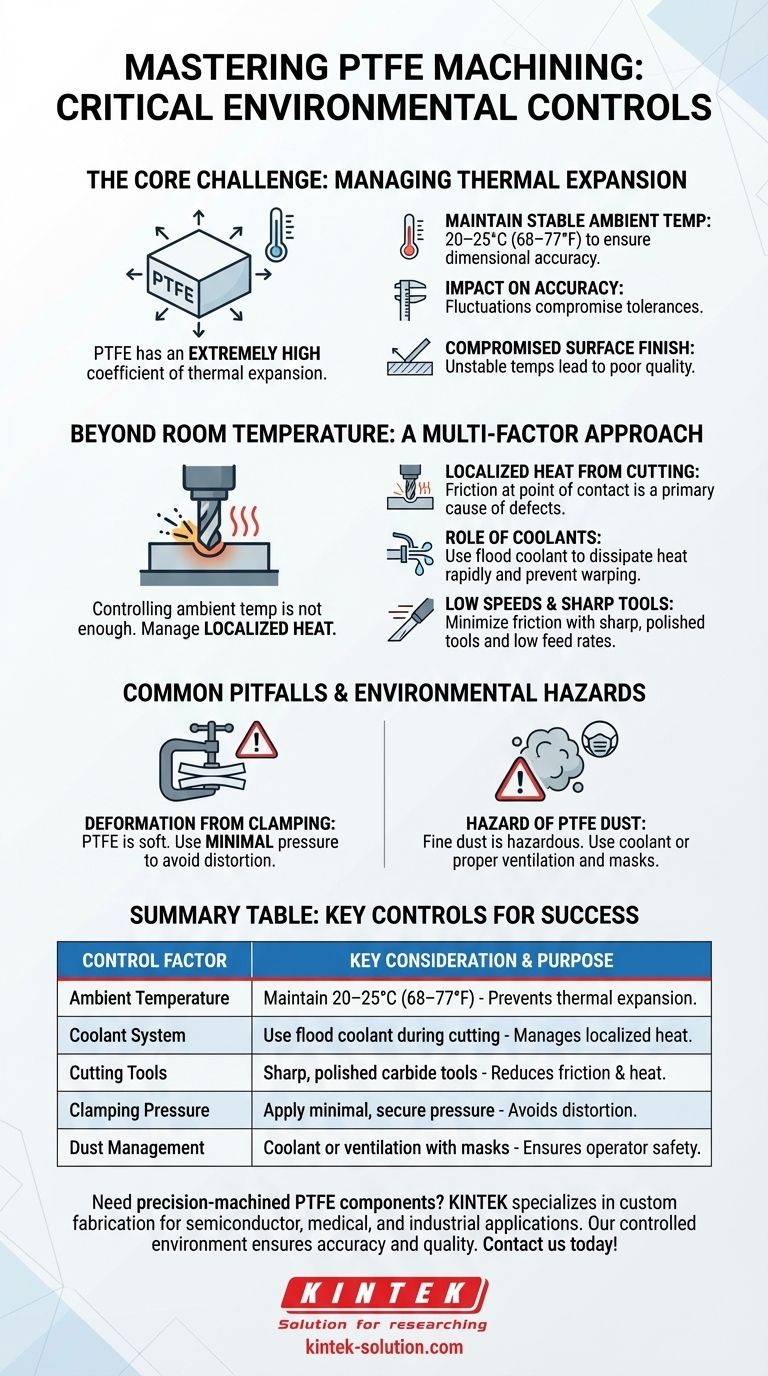Environmental control is critical for PTFE machining because the material possesses an extremely high coefficient of thermal expansion. This means even minor temperature fluctuations cause it to expand or contract significantly, directly compromising the dimensional accuracy and surface finish of the final component. A stable thermal environment is the foundation for achieving tight tolerances.
PTFE's unique properties—its softness and extreme sensitivity to heat—make it notoriously difficult to machine accurately. Success depends on a holistic control strategy that manages not just ambient room temperature, but also localized heat from cutting, mechanical pressures, and airborne contaminants.

The Core Challenge: Managing Thermal Expansion
Polytetrafluoroethylene (PTFE) behaves very differently from metals and most other plastics. Its thermal instability is the primary obstacle to overcome for precision machining.
PTFE's High Thermal Coefficient
Unlike materials like aluminum or steel, PTFE expands and contracts dramatically with changes in temperature. This property must be accounted for in every step of the machining process, from initial setup to final inspection.
The Impact on Dimensional Accuracy
A part measured at one temperature may be out of tolerance at another. Maintaining a stable and consistent room temperature, ideally between 20–25°C (68–77°F), is essential to ensure that the part's dimensions remain predictable.
Compromised Surface Finishes
Inconsistent thermal expansion can also affect the quality of the cut, leading to a poor surface finish. This is especially critical when machining parts with thin walls or complex geometries that are more susceptible to minor variations.
Beyond Room Temperature: A Multi-Factor Approach
Controlling the ambient air temperature is only the first step. The heat generated during the machining process itself has an even more immediate and localized effect.
Localized Heat from Cutting
The friction between the cutting tool and the PTFE workpiece generates significant heat directly at the point of contact. This localized heating is a primary cause of machining defects.
The Role of Coolants
An effective cooling system is non-negotiable. Using a flood coolant dissipates heat rapidly, preventing the material from overheating, warping, or deforming during the cut.
Low Speeds and Sharp Tools
To minimize heat generation in the first place, it is crucial to use very sharp tools with polished surfaces. Combining this with low cutting speeds and feed rates reduces friction and keeps the material stable.
Common Pitfalls and Environmental Hazards
A successful outcome requires anticipating and mitigating the physical and safety-related challenges inherent to machining PTFE.
Deformation from Clamping Pressure
PTFE is a very soft material with low compressive strength. Excessive clamping pressure in a vise or fixture will easily distort or crush the part before a single cut is made. Fixturing must be secure but apply minimal pressure.
Warping from Internal Stresses
Uneven or rapid heating and cooling can introduce internal stresses into the material. This can cause the finished component to warp or move out of tolerance hours or even days after machining is complete.
The Hazard of PTFE Dust
The machining process creates fine PTFE dust. This micro dust is hazardous if inhaled. Therefore, a critical aspect of environmental control is safety—either machining under a flood coolant to contain the particles or ensuring the area is well-ventilated and operators wear appropriate masks.
Key Controls for Successful PTFE Machining
To achieve consistent, high-quality results with PTFE, implement the following controls based on your project's demands.
- If your primary focus is tight dimensional tolerance: Maintain a stable ambient temperature between 20–25°C (68–77°F) and use a flood coolant system to manage localized heat.
- If your primary focus is excellent surface finish: Use extremely sharp, polished carbide tools with low cutting speeds and feed rates to prevent material tearing and heat buildup.
- If your primary focus is part integrity and safety: Employ minimal clamping pressure to avoid distortion and always use coolant or proper ventilation to manage hazardous dust.
Mastering the machining environment is the definitive factor in transforming PTFE from a challenging material into a predictable one.
Summary Table:
| Control Factor | Key Consideration | Purpose |
|---|---|---|
| Ambient Temperature | Maintain 20–25°C (68–77°F) | Prevents thermal expansion/contraction |
| Coolant System | Use flood coolant during cutting | Manages localized heat from friction |
| Cutting Tools | Sharp, polished carbide tools | Reduces friction and heat generation |
| Clamping Pressure | Apply minimal, secure pressure | Avoids part distortion or crushing |
| Dust Management | Coolant or ventilation with masks | Ensures operator safety from PTFE dust |
Need precision-machined PTFE components that meet strict tolerances? KINTEK specializes in custom PTFE fabrication for semiconductor, medical, laboratory, and industrial applications. Our controlled machining environment ensures dimensional accuracy, superior surface finishes, and part integrity—from prototypes to high-volume orders. Contact our experts today to discuss your project requirements!
Visual Guide

Related Products
- Custom PTFE Parts Manufacturer for Teflon Parts and PTFE Tweezers
- Custom PTFE Parts Manufacturer for Teflon Containers and Components
- Custom PTFE Volumetric Flasks for Advanced Scientific and Industrial Use
- Custom PTFE Teflon Balls for Advanced Industrial Applications
- Custom PTFE Measuring Cylinders for Advanced Scientific and Industrial Applications
People Also Ask
- What chemical processing applications involve PTFE-machined parts? Essential Components for Corrosive & High-Purity Systems
- What are the unique properties of PTFE? Unlock Unmatched Performance in Demanding Applications
- What challenges arise when machining PTFE (Teflon)? Overcome Softness, Heat, and Instability
- What design considerations are important for custom PTFE parts? Design for Performance & Reliability
- What finishing techniques are effective for machined Teflon parts? Achieve Functional Performance and Dimensional Stability



















